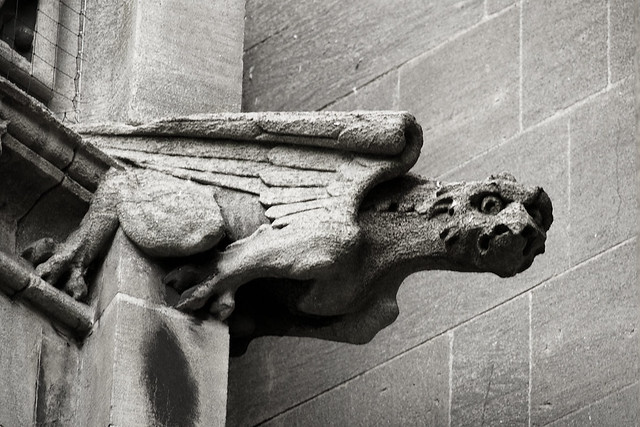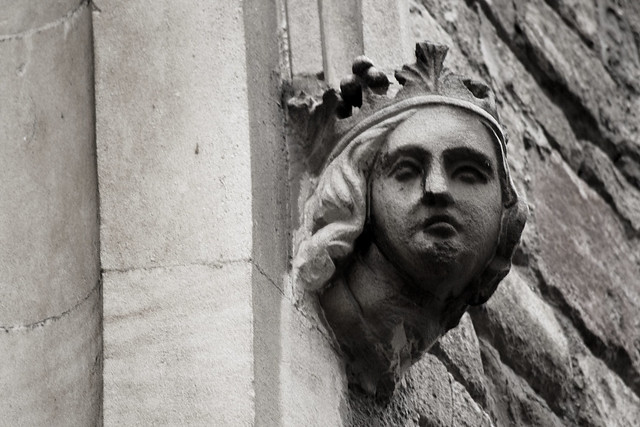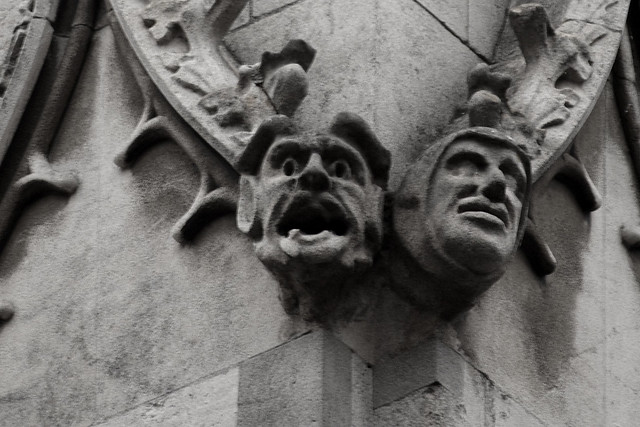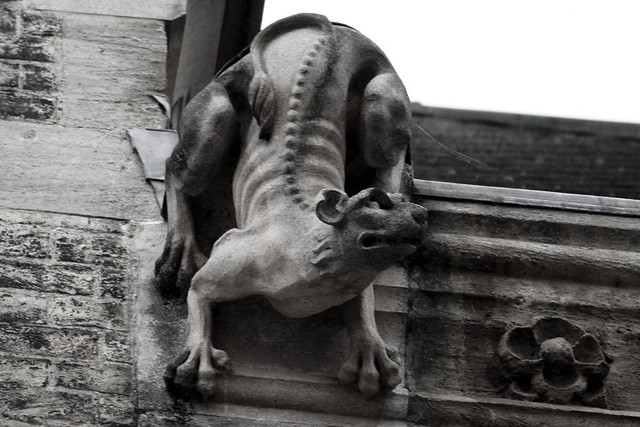The start of the Tudor Court Season at the BBC! 🙂 This is the first of a handful of one off programmes about the Tudors – not concentrating on the stories of Henry VIII and Elizabeth that are so much a part of national mythology, but instead looking at the other central characters of the times. This programme was about the sudden fall of Anne Boleyn from Queen of England to executed adulterous & treasonous “whore”.
First, I’ll get the big nitpick out of the way: throughout the programme Robert Glenister (narrating) repeatedly refers to the events as happening 600 years ago, or six centuries ago, when in actual fact 1536 is a bit short of 500 years ago. A shame, as from reading the comments on the BBC blog post about the programme it seems some people have got fixated on the arithmetic error and haven’t bothered to pay attention to the rest of it. They should’ve got that right tho :/
The programme is billed on the website as “a radical new approach to televised history”, which is a little overblown, but there is a kernel of truth to it. Instead of a cohesive story that is presented as fact we have seven talking heads, plus a narrator, and they do not agree about the interpretation of the facts available. Suzannah Lipscomb in the BBC blog post breaks the theories down like this:
Broadly, the theories about Anne’s death boil down to four possible scenarios:
- that Anne was guilty,
- that Thomas Cromwell and, possibly, the Seymours conspired against her,
- that Henry VIII wanted to get rid of Anne,
- that dangerous talk cost lives and it was what Anne said – rather than what she did – that made her appear, in Henry’s eyes, guilty.
And the talking heads divide up as follows: George Bernard (a historian) was in favour of Anne being guilty. Suzannah Lipscomb (a historian) & Greg Walker (a historian) were in favour of the last of the theories (an appearance of guilt rather than actual guilt). The other four were split between the two conspiracy theories, with Philippa Gregory (novelist, including “The Other Boleyn Girl”) on the Henry-did-it side and Hilary Mantel (author of “Bring up the Bodies” (post)) on the Cromwell-did-it side. I think David Starkey (historian) was also a Cromwell person, and Alison Weir (author of many popular history books, plus some historical fiction) was more on the Henry end of the spectrum. But as I didn’t take notes I may’ve muddled that up a little – there’s a degree of overlap between the two theories anyway, as Cromwell could’ve provided Henry with the means to bring down Anne.
The format of the programme was for the narrator to talk us through the events, and the talking heads gave their opinions on the motivations or causes of things. In between the talking heads there were bits of re-enactment to give us something to look at. I think between them Mantel, Starkey & Lipscomb contributed more than half the discussion but the other four also had space to put their positions.
The programme started by working briskly backwards from Anne Boleyn’s execution on 19th May 1536 via her arrest two weeks earlier, her auspicious start to the year and then started moving forward again from her arrival at court several years earlier. As it wasn’t the focus of the programme we passed fairly swiftly over the intervening years till the start of 1536, just hitting the high points. Anne arrives at court age 21 having spent time in the French court beforehand. She’s intelligent, witty, charismatic, sophisticated … and the King becomes infatuated. He wants her to be his mistress, she holds out for marriage and in the end the King succeeds in divorcing Catherine of Aragon by splitting the English Church from Rome.
So as 1536 starts Anne is married to the King and secure in her position at court. Catherine of Aragon finally dies on 7th January and Henry and Anne celebrate. Anne is pregnant for the second time, and everyone is convinced this time it will be a boy and the heir that Henry needs. All is well. But on the day that Catherine is buried (29th January) Anne suffers a miscarriage, and the dead child was a boy. Henry is devastated, and the pro-“Henry did it” viewpoint identifies this as the beginning of the end for Anne – she’d had miscarriages before and this was a sign to Henry that the pattern was re-asserting itself. Gregory went further and told us about a midwife who examined the baby and discovered it was malformed, and if this was the case then that (in the eyes of 16th Century people) would mean that Anne had committed a dreadful sin or was even a witch. Both Mantel & Lipscomb pointed out that there’s no actual contemporary evidence of this, it’s a story that starts to circulate later long after 1536. Around this time Henry also began to pay court to Jane Seymour, who would be his next wife – again this could be seen as evidence that “Henry did it” but others of the historians pointed out that Henry had several mistresses over his lifetime and there’s no evidence that he was looking for a replacement wife in Jane.
The next major event they covered was a sermon given by Anne Boleyn’s chaplain on Passion Sunday. This had as its theme a warning against treacherous advisers using the story of Haman from the Book of Esther. This is identified by the Cromwell-did-it viewpoint as being squarely aimed at Cromwell, and as a sign of a rift between Cromwell & Anne Boleyn. Cromwell by this stage is the Minister of Everything – all the business of the court passes across Cromwell’s desk. He was also the man who’d managed to find the solution to how the King was to be able to marry Anne, so their rises to power were intertwined. The Cromwell-did-it viewpoint is that they were no longer closely linked, and there was a power struggle going on between them. Countering this Lipscomb pointed out that just because the priest was Anne’s chaplain doesn’t mean that he was speaking on behalf of Anne, we don’t know the motivation behind the choice of text. And it doesn’t seem to make sense for them to be working against each other.
Another thing that happened at this particular service makes it clear that Anne was still in favour with the King – Henry engineered it so that Anne & Chapuys (the Holy Roman Emperor’s Ambassador) came face to face, and Chapuys had to bow to Anne. As he was in the service of Catherine of Aragon’s nephew he had been refusing to meet Anne, and this incident meant that he was forced to choose between being rude and acknowledging Anne as Queen of England. He chose the latter path, quite the diplomatic coup for Henry. And as more than one of the talking heads pointed out, why would he do this if he was already thinking about setting Anne aside?
After this service the King is in conversation with Chapuys, and then the King and Cromwell have a falling out. No-one who heard what was said reported it, but apparently the body language was clear that they were having a row. Cromwell leaves court and stays in his house for a day or two saying he is unwell – he is said to have looked in poor health as he walked away from this charged conversation. They were saying that it’s thought that Cromwell was overstepping his bounds in organising foreign policy. And of course there’d just been that sermon, whether at Anne’s instigation or not it would still seem aimed at Cromwell. It’s after he comes back to court that the whole thing starts to come unravelled for Anne – so this can be seen as more evidence for a rift between Anne & Cromwell. There’s a later letter from Cromwell to Chapuys where Cromwell says that he “made the whole thing up”, but Lipscomb was saying that in the full context of the letter it’s not clear if he made it up from nothing of his own volition, or if he did so at Henry’s prodding or what. I don’t remember if it was spelt out, but I was also thinking that a letter from Cromwell after Anne’s disgrace to a man who had no cause to like Anne might not be the most unbiased source – one can easily imagine reasons why Cromwell might want to claim credit.
The first stage in Anne’s downfall was that rumours about her behaviour started to spread – the incident that sparked it was the Countess of Worcester, one of Anne’s ladies-in-waiting, on being told off by her brother for her loose living says something to the effect of “if you think I’m bad, you should see how the Queen behaves”. Next Cromwell takes a young man called Mark Smeaton away for a chat about this – he was a musician who often played for the Queen & her ladies. The presenters talked a bit about whether or not he was tortured – there’s no direct evidence either way. Apparently torture wasn’t often used at Henry’s court, but set against that is the fact that Smeaton confessed which seems foolish. I remember from Mantel’s novel that she has Smeaton tricked into being boastful. But whatever happened (which we’ll never know) the fact is that Smeaton confessed to having slept with the Queen and named others who also had.
So Cromwell takes this to the King and moves on to a full scale investigation of what’s going on. I think it’s at this point in the programme that they spent a bit of time discussing Henry’s character in relation to why he would believe this. I think Gregory harked back to the theory that Henry as a devout man would see that Anne’s miscarriage was some sort of sign of God’s disapproval. Starkey on the other hand was telling us that Henry was the sort of person who could convince himself of the truth of whatever was convenient. And Anne’s failure to give birth to a male heir and her general demeanour as a woman who didn’t know her place might mean it was convenient to take this opportunity to replace her with someone less arrogant and full of herself, like Jane Seymour. I think it was Lipscomb that brought up the idea that even rumours of adultery were a public relations disaster for Henry – it would be a sign he couldn’t control his own household, and if he couldn’t do that how could he control a realm?
Seven young men are arrested, including Mark Smeaton, Henry Norris (one of the King’s closest courtiers) and Anne’s own brother George Boleyn. They are charged with committing adultery with the Queen, two are later released but five of them go on to be tried and executed for it. All of them except Smeaton deny the charges, interestingly Smeaton never recants his confession. Anne is arrested shortly after them on 2nd May 1536 and taken to the Tower. She denies all the charges, right up to the very end. She defends herself at her trial, but the outcome is a forgone conclusion – she is convicted of adultery, incest and wishing the death of the King and sentenced to be executed. The men are executed on 17th May 1536 and Anne follows two days later. She receives the final sacrament in the Tower before her execution and when she makes her final confession she swore on the threat of eternal damnation that she was innocent of the charges against her. Which Lipscomb pointed out as quite compelling evidence of her innocence – Anne’s about to die and is devoutly religious, risking eternal torment by lying at this point when it can change nothing isn’t in character.
Bernard was the lone voice on the programme suggesting that Anne might’ve been guilty. He drew attention to the fact that when the rumours started to spread and the investigation began no-one stuck up for her or defended her. He also noted that there is a suggestion that Henry was having problems with impotence, and so getting herself pregnant by someone else might’ve seemed the obvious solution to the “how to have a male heir” problem that Anne had. And even the incest with her brother might be explained by this, after all the resulting child wouldn’t look like anyone unfortunate. Bernard also pointed out that Anne & George weren’t brought up together, they met as almost-strangers as adults, so it’s not as disturbing as the modern mind thinks it is.
However Lipscomb pointed out that a lot of the charges were fabricated. The records of the trials are lost, but the list of charges still exists. These are very specific, they list several occasions on which intercourse took place and list Anne plus a named person on a given date in a named place. And even though not all evidence from the time survives modern historians have enough documentation of the places where Anne and the men were during this period to disprove three quarters of the charges because either Anne or the man or both weren’t in the right place at the right time.
Lipscomb & Walker were also keen to point out that the paranoid atmosphere of the court would prevent people from sticking up for Anne – if she’s on the way down you don’t want to get caught in her wake even if you do think she’s innocent. They also pointed out that life for a lady in the court was a tightrope act – you had to appear to be totally chaste, yet also take part in the games of courtly love. Flirt, but not flirt too much. Lipscomb told us that the most damning piece of evidence against Anne was a conversation with Norris where they imply that Norris wants to marry her once Henry is dead. This is taken as evidence by Cromwell that Norris & Anne were plotting the death of the King, but Lipscomb was saying that maybe it was a conversation that just crossed the line a bit too far and happened to be overheard at the wrong time.
I enjoyed this programme (you can probably tell by how much I’ve written about it 🙂 ). I particularly liked hearing the different viewpoints and appreciated that it drew a distinction between “this is a fact” and “this is an opinion”, it was always clear what was known and where people were speculating. Apparently the seven experts were interviewed separately, but they managed to cut the bits of footage together in a way that made it feel like a conversation.





